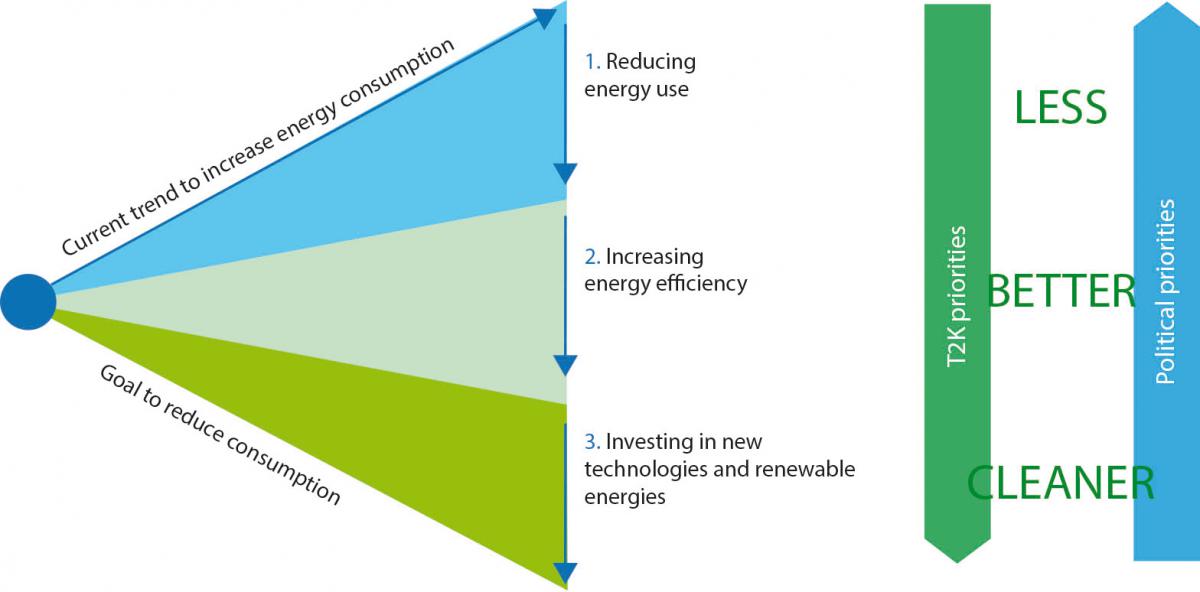The next stage in developing a strategy is to develop an initial list of potential actions to reduce carbon emissions. For the identification of the most relevant actions, it is recommended to organize interactive workshops with internal staff and external stakeholders to:
- Share the expertise among the employees and experts
- Give priorities and list the challenges
- Identify and evaluate the action levers
- Formalize the commitments and prepare the action plan.
The more people are involved in the brainstorming process, the more they will adhere to the strategy and engage themselves on the long term. Within the Ticket to Kyoto project, the collection of ideas and its prioritization relied mostly on internal consultations within the companies and on the exchange of best practices between the five partners.
Strategic approach
Given the context of the company, potential carbon reduction measures must be identified and studied to see whether and when they can be implemented and how far they can contribute to the energy and carbon emissions reduction.
In a first step, T2K partners recommend reducing energy use and improving energy efficiency before considering investments in renewable energy technologies. It is better to consume less energy than to produce renewable energy in order to compensate the emissions of a higher energy use.
The priorities are:
- Reduce energy use (less)
- Improve the efficiency of existing systems (better)
- Invest in new technologies and renewable energies (cleaner).

The first two priorities can be achieved by implementing energy-saving measures without the need for major investments. The energy that can be saved is a direct result of energy conservation or increased efficiency11 . Public transport companies will often gain more quickly by reducing their energy use and developing energysaving strategies that will directly impact on their energy bill with reduced capital costs.
In this sense, the T2K partnership defined the “Quick Win” concept. A Quick Win consists of implementing short-term actions that can bring significant financial and environmental benefits by optimising existing assets and by encouraging more responsible behaviour among staff and subcontractors.
T2K’s definition of a Quick Win:
- Leads to energy reduction;
- Offers a low payback time;
- Has a short implementation period (less than one year);
- Offers tangible energy savings, which can be measured or estimated;
- Can be replicated in another similar context.
Over four years, T2K partners have exchanged information on best practices and proven that energy consumption can be reduced efficiently and significantly without the need for large investments.
However, these improvements will probably not be sufficient for meeting the carbon reduction target set in the carbon strategy. Investments in the transport systems are the core business of a public transport company. Rail or road fleet renewal or refurbishment, new infrastructures, renovation of stations, depots and workshops will have a direct impact on energy efficiency.
In a second step, the company must quantify investments in new energy-saving systems with higher capital costs but often greater energy reduction potential in the long term. Investing in renewable energy production systems will come at last.
The next chapters of this publication will give the reader many ideas for potential energy saving and carbon reduction actions to be implemented in a public transport company. Taken from the T2K partners’ experience, they are presented in two main sections and will be useful when building a comprehensive carbon strategy.
Improve and Invest
- Energy efficiency in buildings and infrastructure
- Energy efficiency in vehicles
- Energy production systems
- Building ecodesign
Influence and communicate
- Staff awareness
- Stakeholders engagement
- Civil society involvement
Characterisation of the actions
Once relevant actions have been identified, they should be characterized to facilitate their comparison and prioritisation. It is important to evaluate the impact of each action on the company. This characterization requires experts to give per action a weight or value to each of the selected criteria.
The criteria shall at least evaluate the impacts on the energy and CO emissions. Others criteria can be freely chosen depending on the company’s policy or priorities. At this stage, the prioritisation is high-level and is not aiming at deeply analysing the potential actions.
Here is a non-exhaustive list of criteria:
- Capital costs
- Operational costs
- Energy savings
- Carbon emissions reduction
- Ease of implementation (technology)
- Employees involvement
- Impact on corporate image
